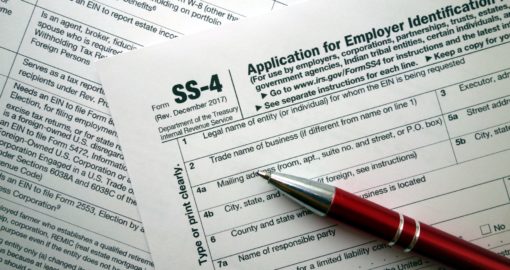Call Us Today (877) 943-0100
7 Best Practices for TIN Matching
TIN Matching + W-9 Verification | May 10, 2021
When your organization decides to contract out work to another company or sole proprietor, typically, you must report any payments made for that work or service to the government on a 1099 Form. The Internal Revenue Service (IRS) will recognize the independent contractor when they receive that form by matching up with their company name and Tax Identification Number (TIN). As simple as that sounds, getting the right business name and TIN is not always a sure thing. This is where a TIN matching service comes in.
When the company name and TIN reported on the 1099 Form does not match IRS records, this generates an error notice where your organization must follow up with notices and attempt to collect the correct information. All of which is time consuming and costly. If errors cannot be settled it can result in potential penalties, fees and withholding tax payments that would otherwise be the contractor’s responsibility.
To avoid, it is best to not only use the IRS TIN Matching Service but to make it just one part of a comprehensive program that will streamline the process to save your organization time, grief, and money.
What is TIN Matching?
TIN Matching is the collection of a company’s legal name and their tax identification number (TIN) and comparing that data to what is on file with the IRS database. This is to confirm that you have accurate information when you report payments on a 1099 Form that are made to an independent contractor that total $600 or more within a year.
The most common TINs are an Employer Identification Number (EIN) or a Social Security Number (SSN). Companies must obtain an EIN if they have W-2 employees and need to pay taxes on payroll. An SSN is used to report taxes for sole proprietors and single member LLCs.
The goal is for the IRS to be able to identify or make a match to the contractor on the 1099 Form so that they can collect taxes owed by that company. As such, they provide organizations with limited access to their system, referred to as their TIN Matching Service, to confirm that the information they have collected is a match or not. Subscribing to the IRS TIN Matching program requires each employee in your organization who is going to use the service, to submit personal information to the IRS, such as tax filing status, residence, and credit card or personal loan information, as proof that they are a resident of the U.S as well as for security purposes. Some organizations opt to outsource TIN Matching for this reason. When you outsource TIN Matching to vendors they can also provide other benefits, such as data reporting.
Here are 7 best practices you should follow when it comes to TIN Matching:
1. Make the W-9 Form Part of Your Recruitment Process
Collecting the W-9 Form before work or service is issued is the best way to obtain the TIN. We recommend including this step in your recruitment process when bringing on new independent contractor relationships. Include this requirement in your contract or agreement packet and make it clear that work will not be issued until you have a valid Business Name and TIN. This alone is an incentive for them to guarantee that you have the right info.
Collecting the TIN later or at end of year is challenging because you are on a time crunch to get the information in time for your 1099 reporting. In addition, a contractor who has long since provided the work or service and has already been paid may be less likely to get you the W-9 and in a timely manner.
Don’t assume that you won’t have to report payments for a particular provider due to tax exemption status or you think you won’t need to file a 1099 Form at end of year. For example, you may use a contractor for work that will cost under $600. You may end up using them later in the year or the job may come in at a higher price than originally thought. Set the expectation that a W-9 Form will always be collected.
2. Withhold Work Until the Name and TIN are Verified
Having the W-9 Form in hand is not enough – the information must also be verified.
Run the business name and TIN through the IRS TIN Matching Service or provide it to a vendor who can do this for you.
The IRS provides two options for TIN Matching.
- If you work with a small number of independent contractors, you can take advantage of their Interactive TIN Matching where you can immediately verify up to 25 companies.
- If you have many independent contractors, then you can submit a bulk TIN Matching request. Be sure not to submit one company more than once on requests or go over the 25 companies on the interactive TIN request as this can lock you out of your account.
Once you receive a confirmed name and TIN combination back as a match from the IRS, then work or services is ready to be issued. If the TIN fails verification, continue to hold work until you can resolve.
There is a reality that sometimes work must be issued before receiving a valid name and TIN. In these cases, do not provide payment for their services until after you have a valid TIN. When work is urgent, it is still best to set the stage that valid W-9 information will need to be provided to receive payment.
3. Tackle Failed TINs from the Start
You will inevitably have TINs that will come back not matching a business name so it is important to have a plan in place so these TINs can be corrected.
Develop a process where you immediately reach out on the failed TINs with a regularly scheduled follow-up. Document details such as your outreach attempts, the date contacted, and if you spoke with someone. Showing due diligence with the IRS can eliminate penalties and fees.
If you obtain a corrected business name or TIN, be sure to run the information through the IRS TIN Matching Service again to guarantee that you have the correct information.
Failed TINs happen for several reasons but the most common is confusion around what TIN and business name a contractor provides to you. You may think that a company should know their TIN and business name however the lines become gray, especially when dealing with different business entities such as sole proprietors and single-member LLCs. For example, as a single-member LLC, you report taxes using your personal name and social security number (SSN), but they may opt to provide you their EIN instead to protect their SSN. Sole Proprietors may also provide their Doing Business As (DBA) name instead of their personal name, which is their legal entity name for tax reporting.
When reaching out for failed TINs, if you obtain corrected information, be sure to run the information through the IRS TIN Matching Service again to guarantee that the new information is correct.
4. Track Data in an Organized Manner
Tracking hundreds or thousands of independent contractors’ business data can become a handful. You will need an organized way to know if a TIN has already been confirmed a match to the business name or not. If you have a system that dispatches work to your contractor network, it is best to make this a part of the requirements to be issued work or to receive payments.
Using a database that will provide you with critical details such as if the TIN was verified or not, when you collected the W-9, attempts to correct a failed TIN, any notices sent and if it was a 1st or 2nd notice will be critical in keeping the process organized as well as provide a history showing due diligence to the IRS, if needed.
5. Double Check the Data
It is a good idea to run a bulk TIN Match of any independent contractors that you work with before end of year taxes and submitting any 1099s. Tracking this data will allow you to easily do this task.
If you have been verifying throughout the year, you may wonder why it is necessary to double check the data. The reason is that working with large amounts of data can get messy and some data may slip through the cracks. Therefore, it is a good idea to run the matching once prior to tax season. It is a lot less work than dealing with IRS error notices. Do not wait till last minute, though. The IRS TIN Matching system gets slower the closer you get to tax season.
6. Secure and Encrypt Personal Information
Securing our data has never been more critical than today. We frequently see data breaches in the news now that more information is stored digitally on servers where hackers have access. Protecting data, especially personally identifiable information such as SSNs, will ensure that your organization does not get into a potentially embarrassing situation that could harm your company’s reputation. Above all, this shows that you care about your independent contractor’s and protecting their personal information and preventing potential identify theft.
Ensure that your systems are secure and that you encrypt any TIN information, especially the SSN. If you are collecting physical W-9 Forms, consider moving to digital copies that are submitted through a secure online platform and redacting SSNs. When storing TIN information in a database, make sure that the field is encrypted and can only be viewed with a key. Also restrict who has access to view this information and only make it viewable to those who really need it.
If you outsource to a vendor, ask questions about their security and any certifications that they hold showing proof that they follow best practices for system security, such as encryption of the TIN, network security such firewall protection, strong and frequent reset of passwords, and regularly scheduled internal employee training on security.
7. Create a Process for Ownership Changes
Knowing when a business has changed hands in ownership is important. There are many reasons, including knowing who to issue payments to and ensuring that you have a signed contract or agreement with the right party. Quite often organizations find out about ownership changes retroactively, leaving a messy trail of clean-up work. The challenge is being able to identify when a change occurs. Begin requesting a W-9 Form when a company needs to change any of their company information. This is usually a sign that there has been an ownership change. If the TIN or Business Name has changed, then you need to treat the company very similar to a newly recruited independent contractor where you obtain a new contractor packet, perform TIN Matching, and have a valid match to provide payment or issue work.
What Not to Do with TIN Matching
Don’t go overboard and collect a W-9 Form every year from your independent contractors. Once W-9 information has been collected and verified, you should be good to go year after year. If the IRS updates their W-9 Form, there is also no need to go back and update old forms received. However, you should update the W-9 Form that you providing to the current version.
By implementing these best practices, you will find that your 1099 reporting at end of year will transform from reactive to proactive, saving your organization resources and money by reducing IRS error notices, extra follow-up, penalties, fees and potentially paying withholding taxes on behalf of the contractor. In addition, you will find other benefits that will further reduce risk such as securing data and ensuring that ownership changes are identified so your organization knows who they are contracted to work with. These steps are important in improving and creating a comprehensive TIN Matching Program.
About PlusOne Solutions
PlusOne Solutions has been an industry leader in the risk management field by specializing in compliance programs that meet the complex challenges of geographically dispersed contractors, vendors, and employee networks. PlusOne Solutions protects companies from possible financial, legal, and reputational risks associated with contractor and vendor relationships while creating safer work environments.
Contents are provided for information purposes only and should not be construed as legal advice. Users are reminded to seek legal counsel with respect to their obligations and use of PlusOne Solutions services.
To receive these updates directly in your email inbox, sign up for the newsletter. Questions or comments? We want to hear from you.
How TIN Verification saved one company expensive IRS fees weeks before tax filing
Errors in reporting inaccurate 1099-Misc forms during tax reporting time can potentially...
Read MoreUsing Your SSN as a TIN Puts You at Greater Risk of Identity Theft – Use an EIN instead
Every day companies share the owner’s personal information, including Social Security Numbers...
Read MoreTIN Matching To Reduce B Notices: How A TIN Matching Program Can Save You Money
Whether you manage your organization’s accounts payable department or contractor recruitment, you...
Read More


